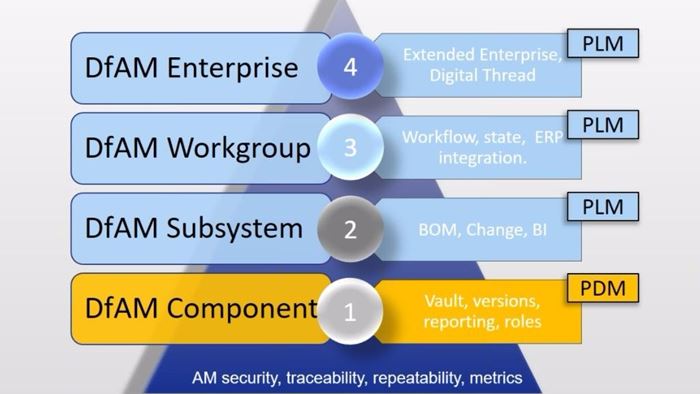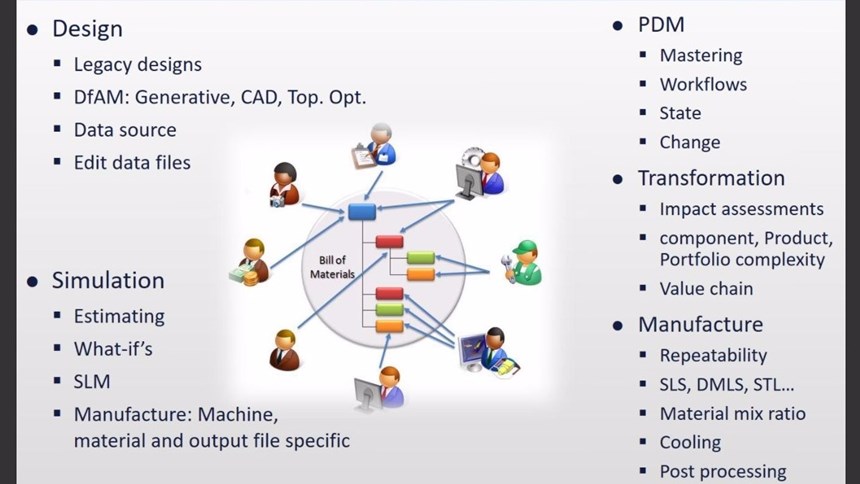Optimizing the Additive Manufacturing Workflow with PLM
Product lifecycle management (PLM) plays an essential role when adopting additive manufacturing within mainstream production.
When asked what type of assistance best fits their additive manufacturing (AM) needs, half of the attendees polled during a recent webinar answered that they need help with product lifecycle management (PLM). What does this have to do with AM? Plenty, especially as the focus on designing for AM and bringing AM into the production environment continues.
When AM was primarily used for producing models, prototypes and one-off parts made of nonproduction-ready materials, governance of enterprise solutions like PLM was not necessary. But with advances in materials, machines and software for AM, along with demand for parts in lower volumes, AM is becoming a production process. To fully implement an AM part and process, information must be integrated with the digital thread, and that means managing data.
The digital thread can be understood as a high-level description of what PLM does, connecting all the digital information (files, meta data, documents, etc.) throughout the product’s lifecycle, from ideation, simulation, optimization and validation, all the way through to printing, cooling and postprocessing. James White, CIMdata’s director of AM Practice, says that “unfortunately, many companies involved in AM do not consider this. Instead, they see an AM machine as just a piece of production equipment, like a molding machine, meaning they see it as an isolated silo.”
This approach is risky. Few companies are even considering PLM to manage AM data and its workflows. While some respondents to a live poll said they use Windows folders, most reported using nothing to manage their AM part data today—not PLM, not product data management (PDM) and not enterprise resource planning (ERP).
“Remember, PLM is a business strategy, not a software tool, and design for additive manufacturing (DFAM) falls under PLM.”
A Department of Homeland Security assessment shows that manufacturing made up a sizeable portion of the cyber incidents that the Industrial Control Systems Cyber Emergency Response Team responded to in 2016.
“AM digital information is at risk,” White says. “You must have secure enterprise governance and IT support, and PLM can help with this. Remember, PLM is a business strategy, not a software tool, and design for additive manufacturing (DFAM) falls under PLM.”
Currently, the workflow for DFAM is flawed, as the mix of human, generative, simulation and optimization stages is not seamlessly connected, which leads to out-of-control issues, lost time and an increased risk for error. At the same time, PLM templates and forms don’t consider AM. PLM templates are designed for traditional manufacturing.
“Basically, PLM exists to manage product information of traditionally made products,” White says. “Now we introduce either an AM part mixed into a traditional part or a wholly AM part, and all the corporate standards that are in place for traditionally made parts in PLM—forms, search, workflows, bill of materials (BOM) structures, release processes, integrations to other applications such as ERP and change management—are not expecting an AM part with its unique characteristics.”
AM As a Workstream of PLM
So, how do we implement PLM to manage AM parts and processes? Let’s take a closer look at AM as a workstream of PLM because, in the end, the AM product needs to meet all the same corporate standards of cost/time, quality, stock keeping, unit numbering and so on as a traditional one to be shipped to customers. “For example, if a single AM part in a car, plane, iPhone, etc. is not meeting all governance standards, it might jeopardize the entire product. Think of the Space Shuttle Challenger, Prius, Tesla and Samsung Galaxy,” White says.
PLM provides governance over the planning, conceptualization, design, validation, production and service of the manufacturing process, while AM touches various departments, disciplines, workflows and systems across an entire enterprise—for example, file editing, material management, controlled cooling, trials, production and postprocessing. This implementation requires flexibility and business transformation.
“AM intersects with design, simulation, topology optimization, PDM and manufacturing, and when fully embraced, it requires business transformation. Because there are things we can stop doing by adopting AM, but there are new things we must start doing. So, we must consider the business impact,” White says.
At the center of this workstream is the BOM, which includes DFAM and everything else downstream of design. Here is how White explains the product information flows through a company in an AM enterprise and how PLM manages the digital data as it progresses: Product structures start as requirements, which become features in a BOM that move through the workflow (engineering to manufacturing, etc.) collecting more data as they go along. All parts must adhere to defined quality, cost and time metrics to ensure the final product can be shipped. AM presents different challenges compared to traditionally manufactured products, as AM engineers need the ability to print or manufacture parts throughout the product’s lifecycle. PLM must embrace and support AM processes to enable a company to scale AM into production.
The DFAM Pyramid
CIMdata has developed a four-tier approach to implement PLM for managing AM parts and processes called the DFAM Pyramid (see Figure 1 above). A foundation of AM security, traceability, repeatability and metrics supports the four DFAM tiers: component, subsystem, workgroup and enterprise. The component tier represents single parts; the subsystem tier represents a collection of parts; and the workgroup and enterprise tiers introduce the organizational aspects of making components and subsystems, representing how a company functions.
Here are the data management capabilities required at each of the tiers, which illustrate the digital thread that connects all the AM information throughout the product’s lifecycle:
| Pyramid Tier | Required Data Management | |
| 1 | DFAM Component | plan, data, approach and management, requiring PDM as a basic management tool |
| 2 | DFAM Subsystem | BOM, change and business intelligence, requiring PLM |
| 3 | DFAM Workgroup | workflow, state and ERP integration, requiring PLM |
| 4 | DFAM Enterprise | extended enterprise and digital thread, requiring PLM |
To implement DFAM one must consider the AM workgroup (the work activity closely coupled with the machine) and its workflow (powder management, CAD/CAE, PDM, printing, cooling, unpacking and postprocessing), as well as the enterprise (all the other departments and tools outside of that AM workgroup that are involved).
“The AM workgroup wants autonomy and is treated like a production machine, when in reality, each side must share data and keep each other in sync when changes occur,” White says. Exploring the interaction between the two sides helps reconcile the flexibility demands of the AM workgroup with the governance requirements of PLM.
How can companies achieve needed governance using PLM to keep track of the AM workgroup workflow? The ideal workgroup interaction requires striking the right balance between PLM and AM and keeping everything traceable and repeatable. This includes:
- AM workgroup members using PLM to manage the specific AM workflow for simulation lifecycle management, PDM, AM production, quality, machine/material characteristics and postprocessing.
- The engineering department executing quality tasks or changes to geometry and structure using PLM with automated version/revision control.
- AM workgroup members accessing PLM using specific AM templates, search fields and forms, linked to a PLM database.
- AM workgroup members linking AM workgroup software solutions and PLM, so that business intelligence dashboards show the state of all AM components against defined key performance indicators such as time, material and cost.
Related Content
Aluminum Gets Its Own Additive Manufacturing Process
Alloy Enterprises’ selective diffusion bonding process is specifically designed for high throughput production of aluminum parts, enabling additive manufacturing to compete with casting.
Read MoreVulcanForms Is Forging a New Model for Large-Scale Production (and It's More Than 3D Printing)
The MIT spinout leverages proprietary high-power laser powder bed fusion alongside machining in the context of digitized, cost-effective and “maniacally focused” production.
Read MoreLarge-Format “Cold” 3D Printing With Polypropylene and Polyethylene
Israeli startup Largix has developed a production solution that can 3D print PP and PE without melting them. Its first test? Custom tanks for chemical storage.
Read MoreHow Siemens Energy Applies Additive Manufacturing for Power Generation and More
At an applications center in Orlando, Florida, a small team of AM specialists is spanning industries by 3D printing parts to support both Siemens Energy power generation systems and external customers.
Read MoreRead Next
3D Printing Brings Sustainability, Accessibility to Glass Manufacturing
Australian startup Maple Glass Printing has developed a process for extruding glass into artwork, lab implements and architectural elements. Along the way, the company has also found more efficient ways of recycling this material.
Read MoreAt General Atomics, Do Unmanned Aerial Systems Reveal the Future of Aircraft Manufacturing?
The maker of the Predator and SkyGuardian remote aircraft can implement additive manufacturing more rapidly and widely than the makers of other types of planes. The role of 3D printing in current and future UAS components hints at how far AM can go to save cost and time in aircraft production and design.
Read MoreHybrid Additive Manufacturing Machine Tools Continue to Make Gains (Includes Video)
The hybrid machine tool is an idea that continues to advance. Two important developments of recent years expand the possibilities for this platform.
Read More























